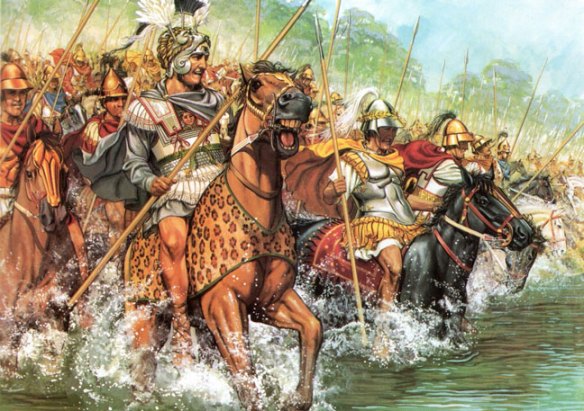In September 326, the Macedonian forces returned from their campaign in the eastern Punjab to Nicaea and Bucephala on the Hydaspes. The new settlements had been ravaged by the monsoon, but the fleet building program begun in the month after Alexander’s victory over Porus was in full swing. In addition to the ships that had been prepared in his absence, Alexander built others, until the grand total of vessels – warships, troop and horse transports, supply ships, and native craft – had swollen to nearly 2,000. Reinforcements, equipment, and medical supplies from the west raised the morale of the troops, and the expedition was launched with great fanfare and supplication of the gods. Thus began a systematic conquest of the Indus region, as the armada moved impressively downstream, flanked on either side by the heavy infantry and elephants. The path to the Ocean would take them past the confluences of the great tributaries of the Indus and through the lands of Porus’ traditional enemies, the Sudracae. These peoples had paid tribute to the Achaemenid kings through the satrap of Arachosia. To the south lay the Sibi, Aggalasseis, and Adrestae; and even these were linked by remote traditions – at least as far as the Greeks understood them – with Heracles. Beyond was the land of Sindh (Hinduš) and the delta region of Patalene. The army marched, divided by the river, for logistical reasons, for maximum military effect, and to keep apart commanders who had now turned to feuding.
Alexander’s two most trusted officers and friends, Hephaestion and Craterus, had come to blows in the days that followed the Hydaspes battle, and their personal rivalry had spread to their respective troops. Such friction between officers is common enough in armies, but Hephaestion had a special talent for making enemies. He was abrasive and quarrelsome, no doubt because his friendship with Alexander allowed him to offend with impunity. But many of the hetairoi attributed his promotion to higher offices to Alexander’s personal favor rather than merit. The king did nothing to dispel such notions by publicly calling Hephaestion “a fool and a madman, if he did not realize that without Alexander he was nothing.” Nevertheless, in any dispute, Hephaestion had the advantage of being able to plead his case with Alexander in private, and although Craterus had the respect of the soldiers and officers alike, his opponent had the king’s ear. From this point on, we see the decline of Craterus’ authority. The forces were divided as follows: Alexander, with the hypaspists, Agrianes, archers, and the agema of the cavalry, sailed with the fleet; Craterus, with a share of the infantry and cavalry, marched along the western bank of the river; Hephaestion, with the larger and more powerful contingent, as well as some 200 elephants, descended along the eastern bank. Before the army reached the Indus Delta, Craterus would be sent westward through Drangiana with the heavy infantry, many of whom were scheduled to be demobilized.
Alexander had been wounded leading the troops who were scaling the walls, he found himself inside the Mallian stronghold with only a few personal guards. The king was carried to safety, but the sources disagree about who treated the wound: some said Critobulus (a physician who had once removed the arrow from Philip II’s eye at Methone); others claim that the task was given to Perdiccas, the man who was to play a major, but short-lived, role in the age of the Successors. As in virtually every case where Alexander was wounded by the enemy, the conquered paid a price in blood, as the Macedonians consoled themselves with wanton slaughter.
Some have suggested that the soldiers were war-weary and reluctant to engage in further battle and that they exposed their king to danger through their sluggishness. If this is true, the lapse was a very short one, and no recriminations were ever made – except by modern scholars. Certainly, later on, when the fleet continued its descent downriver, a rumor that Alexander had died, and the suspicion that their officers were withholding the truth from them, caused a near riot of the troops. The king was placed on the deck of the ship, where he could be seen by the men, who looked for any wave or nod as a sign of life and approval.
The remainder of the Indus campaign seemed, by comparison with the conquest of the Punjab and the Mallians, little more than a formality. Local dynasts surrendered at the news of Alexander’s approach, though some, like Musicanus, oscillated in their loyalty to the conqueror and paid the extreme penalty; the Brahmins, who incited his defection, were slaughtered in great numbers. Likewise, Oxicanus and Porticanus – if they were, in fact, different individuals – rebelled, only to be arrested by contingents sent out by Alexander. One other dynast, Sambus, a neighbor and rival of Musicanus, first fled and then surrendered. From Musicanus’ kingdom, Alexander controlled the route leading from Alor to Kandahar (Alexandria-in-Arachosia), along which he sent Craterus and the bulk of the heavy infantry, those unfit for military service, and the elephants westward to mop up resistance in Drangiana. The king himself advanced to Patala and sailed down both arms of the Indus to the Ocean. Peithon son of Agenor was left behind as satrap of Sindh, but it must have been clear to Alexander that the administration of the satrapy would prove difficult at best.
